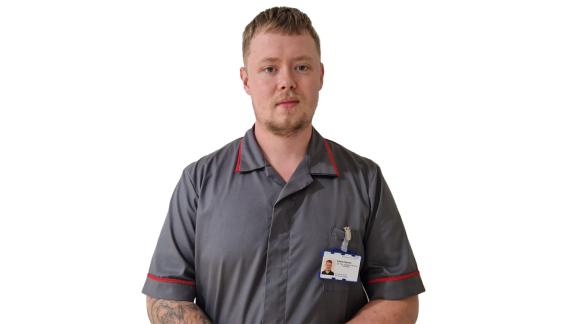Nursing associates at Chesterfield Royal Hospital NHS Foundation Trust

2022 marks the first revalidation year since the nursing associate (NA) role was introduced. So we have spoken to a variety of employers and NAs from across England to find out how the role was adopted and continues to develop as an integral part of the NHS workforce.
In 2017, the East Midlands made a bid as a pilot site to host the nursing associate (NA) role. Each of the counties in the East Midlands region worked with their partner universities to develop different models for the NA training programme; Chesterfield is part of the Derbyshire Integrated Care System (ICS)/Health Education England (HEE) network and worked with Derby University to develop a programme.
At Chesterfield Royal Hospital we had ten trainee nursing associates (TNAs) in the first cohort and have been running two cohorts of various sizes each year since then. This year we are recruiting an additional thirty-seven TNAs as part of our overall safe staffing workforce plan, as the role is now embedded in our ward teams.
We approached the role with a workforce planning focus, as we had a chronic nurse vacancy issue in the trust. There were somewhere between seventy and eighty registered nurse vacancies which were difficult to fill. The intention was to amend the skill mix on adult acute wards to help reduce the vacancy gap. The plan was to have around seventy NAs – one NA for every daytime shift, seven days a week. We still haven’t entirely achieved that target, but we have extended the reach of NAs, now have NAs working night duty, which up until recently wasn’t the case. This development followed a review of our ward establishments and a move to three registered nurses on night duty, one of which can now be an NA.
Something that has enabled this development is our more experienced NAs, who have completed the 12-month preceptorship. They can undertake IV drug administration, which is a critical skill for night duty where there is a large number of IV drugs to administer. We’ve now identified that we need to train even more NAs to support IV drug administration. It’s also important that we maintain recruitment to NA training because a lot of the qualified NAs want to top up to become first level registered nurses.
For example, two NAs from the first cohort, have already progressed to registered nurses (RN) and one is completing paramedic training. NAs get access to the apprenticeship degree courses to aid their development, and many have specialised in areas such as oncology and community services. Other NAs have taken a sideways step into the role from other NHS roles to further their development. This has helped enormously with the need to constantly re-staff ward environments.
One of our staff nurses Kayleigh Aulton, shared her development journey and highlighted the progression opportunities available to NAs:
“I had been qualified as a nursing associate for two years before I then made the choice to apply for university again to complete my degree and do an eighteen month top up to be a staff nurse. I decided to go back to university to become a nurse to expand my knowledge and skills. I've been lucky enough to come this far in five years and climb the ladder and I'd tell anyone they’d be silly to pass the opportunity to learn!”
We think the NA role has brought a real continuity of care to clinical environments. A patient is often exposed to multiple members of staff, but NAs can reduce this and provide more holistic care, particularly when they are trained to do IV medication.
As part of our evaluation of the role, supported by NHS Employers and other stakeholders, it was reported that there was some considerable anxiety about RNs being accountable for NAs, as well as concerns with role conflict and safety. It was found, and we continue to find, that harms didn’t increase with the introduction of the NA role, and with increased education about the role, we have seen staff concerns reduce. There appears to be a preference among staff for NAs instead of agency RNs. This helps provide consistency in the team and with our service users and seems to be more effective all round.
The role has also provided clarity on career development for healthcare assistants (HCAs), some of whom would have been unable to go on to registered qualifications due to the cost implications. Now they can ‘earn as they learn’ with the apprenticeship route, which helps us retain a constant flow of HCAs. There are a number of people who can’t afford to take three years out of work to complete RN training, particularly on the current salary, and the gaps this creates in the workforce can also be very challenging.
We’ve found that NAs make such an impact on reducing the need for agency staff, which frees up funds to support the development of other roles such as the advanced clinical practitioner (ACP). However, it is important to say that reducing costs was not the key driver for the implementation of the NA role. The key driver was to help fill the nursing skill mix gap and we introduced the role as part of the ‘Safer staffing strategy’; freeing up financial support was a secondary consequence.
Our recruitment has improved, with a focus on career development and apprenticeship pathways. We’re going to be recruiting TNAs as HCAs for a few months initially, to get settled, and we’ll then put them onto the NA foundation degree. If they then want to top up, we can then support them to do this.
Where this pathway isn’t possible due to capacity, NAs can still complete the eighteen-month top up degree via a student loan route, which is also financially viable. Our local university and TNA provider is the University of Derby, and quite early on they introduced a direct entry NA course (two- year student programme), whereby TNAs come to the trust on a placement, the same way a first level registered nurse student would. This way, they get to experience the organisation first hand and at the end of the programme we can then recruit them as qualified NAs. At the end of the TNA programme, we also have a lot of qualified NAs who go on to finish the RN programme, which may not have been a possibility for many individuals via the traditional three-year RN programme.
The trust also provides an adoption scheme at the end of the first year of the direct entry programme. TNAs can then complete the course as an apprentice in the second year and their second-year course fees are paid for. Because they’ve had a placement already, they’ve had a chance to adapt to the organisation’s values and behaviours. Our ongoing RN recruitment adverts now also includes the recruitment of NAs.
For more information please contact: maxine.simmons@nhs.net



